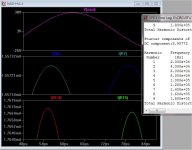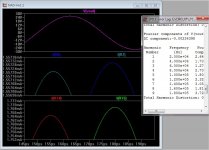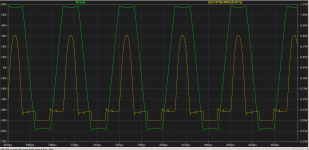http://www-personal.umich.edu/~dsbaero/library/HongSpilloverTCST1998.pdfThanks for this link Waly.
I will now pre10 2 reed dis 2 mek yus gurus bleaf i ken reed en rite 🙂
I'm actually preparing a post on a similar topic, Bode's Max F/B, in reply to Andrew (Bonsai) & Bob Cordell's assertion that evil EF3s are tailor made for CFA & VFA amps. 😱
Probably take the discussion off this thread cos it is generally applicable and the S/N is poor here.
Waly, your point about the parallel paths in 'symmetrical' CFAs leading to more gm etc is spot on. I hope Andrew takes this into account in his excellent analysis.
______________
Christophe & others, I believe Waly is making a genuine effort to be constructive and has recently posted some valuable insights. Please encourage him in this.
The odd 'yus are all idiots & deaf' remark still slips through but both sides have been guilty of this .. alas contributing to the poor S/N 😡
I have managed to hold my tongue and am proud that I did so even when the High Priest of Snake Oil (His name shall be unsaid) actually appeared on this thread.
Lets not belittle efforts to raise the tone of this conversation. Guru Cordell shows how it should be done .. even when he disagrees strongly with certain views 🙂
I will now pre10 2 reed dis 2 mek yus gurus bleaf i ken reed en rite 🙂
I'm actually preparing a post on a similar topic, Bode's Max F/B, in reply to Andrew (Bonsai) & Bob Cordell's assertion that evil EF3s are tailor made for CFA & VFA amps. 😱
Probably take the discussion off this thread cos it is generally applicable and the S/N is poor here.
Waly, your point about the parallel paths in 'symmetrical' CFAs leading to more gm etc is spot on. I hope Andrew takes this into account in his excellent analysis.
______________
Christophe & others, I believe Waly is making a genuine effort to be constructive and has recently posted some valuable insights. Please encourage him in this.
The odd 'yus are all idiots & deaf' remark still slips through but both sides have been guilty of this .. alas contributing to the poor S/N 😡
I have managed to hold my tongue and am proud that I did so even when the High Priest of Snake Oil (His name shall be unsaid) actually appeared on this thread.
Lets not belittle efforts to raise the tone of this conversation. Guru Cordell shows how it should be done .. even when he disagrees strongly with certain views 🙂
Balance and offset
(below 1) - I "balanced" this CFA to the max. Has a horrible 2V+ output
offset but the pair(s) of both input stages are more balanced than
any real amp could hope for.
(below 2) - I WAS WRONG 😱 , adding the servo DOES "unbalance"
the devices ..... just a little ! But I now have 2mv offset 😎 .
OS
(below 1) - I "balanced" this CFA to the max. Has a horrible 2V+ output
offset but the pair(s) of both input stages are more balanced than
any real amp could hope for.
(below 2) - I WAS WRONG 😱 , adding the servo DOES "unbalance"
the devices ..... just a little ! But I now have 2mv offset 😎 .
OS
Attachments
Stanley Lipshitz and John Vanderkooy both made exceptional contributions to the field of audio, not just in a confined area, but over a very broad range of topics. I've sat through countless presentations of theirs at AES conventions since the mid-late 70's and enjoyed every one of them, even if some of the math was over my head. Stanley is a Fellow of the AES and a recipient of the Silver Medal for his pioneering work on dither in digital audio.
Cheers,
Bob
Yes, of course they have. No need for anyone to jump to their defense.
Just because SL -in this case - didnt contribute but an excellent intellectual exercise is not an indictment of all his good work. My point is that HERE in DIY-land and else where we can get all involved in minute details (1-2dB) and miss looking into more fruitful areas.
Thx-RNMarsh
My point is that HERE in DIY-land and else where we can get all involved in minute details (1-2dB) and miss looking into more fruitful areas.
How are these "more fruitful areas" selected? By popular vote?
How are these "more fruitful areas" selected? By popular vote?
Sometimes by popular vote. You know... majority rule.
I still come back to this -- if there is no silver bullet to explain any real nor significant differences (performance) which cannot be obtained and matched by either topology - why does the IC industry make a distinction of the two topologies in their product line up? What do they know that we dont acknowledge here? [ and No, it isnt marketing]
Thx-RNMarsh
- if there is no silver bullet...- why does the IC industry make a distinction of the two...
What do they know that we dont...
Scott Wurcer already made a very informed and perceptive post about exactly this, in response to an earlier post of yours.
A prime reason was that the "CFA" properties made it more convenient and easier for the customer to stay close to optimal compensation as the gain was altered to suit different circuits. Typically for a certain application area so not too wide a variation.
His comment was that for a specific circuit with a known gain they could both be optimised fairly similarly.
Best wishes
David
Found it. #2709. and similar by Scott.
"Integrated CFA's gained popularity in high speed A/D buffering and video where a small range of relatively low gains (6-20db) had relatively similar performance with less need for customization (i.e. work)."
If the designer can set all the parameters of the amplifier and is designing to a set goal of say 23dB closed-loop gain then there could possibly be no benefit.
Last edited:
---http://www.ti.com/lit/an/slod006b/slod006b.pdf
Chapter 9 .... why TI has not "dumped" VFA and why CFA is the only way
for VHF (or video).
Chapter 9.6 ...
Real good explaination to the ?? , and a good "condensation" of the differences.
Is this literature in error ?
OS
Chapter 9 .... why TI has not "dumped" VFA and why CFA is the only way
for VHF (or video).
Chapter 9.6 ...
Real good explaination to the ?? , and a good "condensation" of the differences.
Also , the devices used (mosfets) became faster than VFA could support , as well.The ideal gain equations are identical, but the applications are very different because the
VFA is best applied to lower frequency precision jobs while the CFA applications are in
the very high frequency realm. The transimpedance in a CFA acts much like the gain does
in a VFA. In each case, transimpedance or gain, it is the parameter that enables the use
of feedback.
Is this literature in error ?
OS
Hi OS,
My simulation of a similar diamond input to that of yours in post #3673 indicated a possibility of the 2nd transistors of the diamond IPS (Q5 and Q6) being exposed to heavy power dissipation under over driven conditions. As small as 3dB over driving can cause over 0.8W peak dissipation on these transistors. At higher driving levels the power dissipation goes up as well. I was not simulating on exactly your amp circuit but perhaps you may want to have a look. I had +/-64.5V on the front end rails when doing the simulation.
My simulation of a similar diamond input to that of yours in post #3673 indicated a possibility of the 2nd transistors of the diamond IPS (Q5 and Q6) being exposed to heavy power dissipation under over driven conditions. As small as 3dB over driving can cause over 0.8W peak dissipation on these transistors. At higher driving levels the power dissipation goes up as well. I was not simulating on exactly your amp circuit but perhaps you may want to have a look. I had +/-64.5V on the front end rails when doing the simulation.
Attachments
Last edited:
" . . .[ and No, it isnt marketing]"
Of course it's not. I little grist for the mill on my part he he 😀
Of course it's not. I little grist for the mill on my part he he 😀
Sometimes by popular vote. You know... majority rule.
I still come back to this -- if there is no silver bullet to explain any real nor significant differences (performance) which cannot be obtained and matched by either topology - why does the IC industry make a distinction of the two topologies in their product line up? What do they know that we dont acknowledge here? [ and No, it isnt marketing]
Thx-RNMarsh
you might note that CFA monolithic op amps didn't happen until fast bipolar Q could be made on the same chip
a point some of us keep returning to is that in the IC the output Q are of the same order speed as the rest of the Q so the "CFA speed advantage" means something significant in performance
which contrasts with the audio power amp example where power output (BJT) Q are 10x slower than the small signal Q - the slow output Q, and the additional power discrete packaging/board wiring parasitics (applies to, limits otherwise “fast” MOSFET) pretty much make the ips "speed advantage" of CFA irrelevant
CFA op amps are highly successful in >100 kHz applications vs similar generation VFA "universal" unity gain stable VFA op amp chips which have ro be made in seperate decompensated versions for specific gains - while you get to tune the decompensation of CFA with the feedback network Z
in discrete audio amp design of course VFA compensation is readily tailored to the part's speed, loop gain - so the CFA "bulit in" decompensation again fades as an "advantage" in discrete builds
for audio power amplification we have really strong evidence that performance in the "conventional audio frequency" range really does explain just about anything that has been established as "real" in DBT controlled listening tests
and VFA can easily excel there by applying high loop gain in addition to all the “linearize before closing the loop” tricks
even the "ultrasonic hearing" critique about amplifier ultrasonic IMD still relied on hearing the difference product in the conventional audio range
I am pretty sure that well designed, "high feedback" VFA using heavy output Q bias, Bob's work, heck even his 1984 amplifier, that there would not be audible IMD difference with the signals of the test
so yes people can still design, build, buy poor performing examples of audio power amps - likely in any technology you care to name
the “conventional engineering” community who actually did read broadly on signals, systems, feedback theory, parts parasitics/nonideal behaviors and psychoacoustics, transducer design, the recording and playback signal chain, those who actually “got” Otala's point, And ignored his flawed prescriptions could design fine audio power amps 30 years ago
if not the strawman "engineer" made up by the audiophile gurus
Last edited:
Scott Wurcer already made a very informed and perceptive post about exactly this, in response to an earlier post of yours.
A prime reason was that the "CFA" properties made it more convenient and easier for the customer to stay close to optimal compensation as the gain was altered to suit different circuits.
I remember. My conclusions also are similar --- and I have said so.... much easier to compensate and to get very low HF thd. But my question was also for Waly and what he thought would answer that question. Waly seems to have some very clear ideas/thoughts about this topology.
Thx-RNMarsh
Last edited:
(below 1) - I "balanced" this CFA to the max. Has a horrible 2V+ output
offset but the pair(s) of both input stages are more balanced than
any real amp could hope for.
(below 2) - I WAS WRONG 😱 , adding the servo DOES "unbalance"
the devices ..... just a little ! But I now have 2mv offset 😎 .
OS
You can still use a pot on the hi-z input on a CFA. This will probably require a DC blocking cap so that the driving source does not screw with it. Might give it a try on my next design.
Sometimes by popular vote. You know... majority rule.
 Good engineering criteria
Good engineering criteria 
I still come back to this -- if there is no silver bullet to explain any real nor significant differences (performance) which cannot be obtained and matched by either topology - why does the IC industry make a distinction of the two topologies in their product line up? What do they know that we dont acknowledge here?
They know that in monolithic ICs it is not necessary the output stage pole that dominates the open loop gain frequency response, like in discrete power amplifiers. Output stages frequency response is of the same order of magnitude as the gain stages. And that bipolar transistors in dielectrically insulated technologies, npn and pnp, have the same order of magnitude Ft~1-2GHz. Hence, ICs do not have the same limitations in design and compensation as audio power amplifiers.
They also know that CFAs properties are relevant for low closed loop gains, some 6-12dB typically for DSL lines.
They also know that video application require tight phase control in the upper MHz range, audio does not.
From #64
Are we there now? I think we are.
-Richard Marsh
First you/we want to understand what a CMA IS. We'll get to the sound.... that is a bit of a leap from where we are now and not about the topology characteristics. So, at this point, we wont be able to design CMA's if we dont understand what we are doing or talking about clearly when it comes to the CMA case.
Right now, we dont know if it offers any advantages or what they may be because we dont even know what it is or how it is defined nor understand the strategy of it. I think its best advantage will show in high level amps at higher audio freqs. That would mean line level into low Z loads and power amps for audio. But, we arent there yet on this forum.
Thx-RNMarsh
Are we there now? I think we are.
-Richard Marsh
Last edited:
Hi OS,
My simulation of a similar diamond input to that of yours in post #3673 indicated a possibility of the 2nd transistors of the diamond IPS (Q5 and Q6) being exposed to heavy power dissipation under over driven conditions. As small as 3dB over driving can cause over 0.8W peak dissipation on these transistors. At higher driving levels the power dissipation goes up as well. I was not simulating on exactly your amp circuit but perhaps you may want to have a look. I had +/-64.5V on the front end rails when doing the simulation.
That would be the same as any of these DIYA CFA's , they don't have clamps.
ksa992/sc1845 have 500mW continuous dissipation . 800 might be tolerable
for repetitive. 1W resistors and perhaps a more robust to-92 device could be
in order. I'll look into it - I expected this.
PS - I could go all the way with the active clamps , I never tried them on a
Hawksford. 😉
OS
Good engineering criteria

If you wanted a serious answer, it would be thru a process of prioritizing. But, gee Waly, I wouldnt know anything about how to do that. 🙄
Thx-RNMarsh
This is the 'magic sauce' that Esperado keeps finding ...... much easier to compensate and to get very low HF thd.
The VFA Accuphase models you listed are all out of production.
All their current models are CFA.
So yes, Accuphase has "given up" on VFA.
If multimillion company with pedigree did this, there must be a good reason.

TL71/72 for servo should be ok. No need for expensive opamps.
The DC servo is in the signal path. Everyting counts. Just like that electrolytic you are trying to avoid.
Cheers,
Bob
Ditto.
Socket the servo opamp and try a few different types.
You will be surprised
T
[CFAs are] much easier to compensate and to get very low HF thd.
What would you consider as valid proof that what you just said is, in general, incorrect?
it would be thru a process of prioritizing
I would appreciate if you could expand on this. I've asked how you would select/choose the "more fruitful areas", not how you prioritize them.
Last edited:
- Home
- Amplifiers
- Solid State
- CFA Topology Audio Amplifiers


